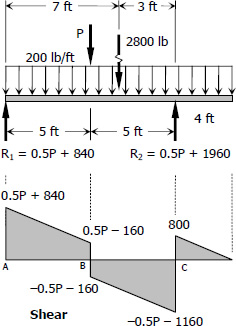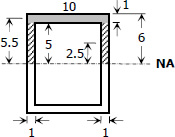
$\Sigma M_{R2} = 0$
$10R_1 = 5P + 3(2800)$
$R_1 = 0.5P + 840$
$\Sigma M_{R1} = 0$
$10R_2 = 5P + 7(2800)$
$R_2 = 0.5P + 1960$
$M_B = \frac{1}{2} [ \, (0.5P + 840) + (0.5P - 160) \, ](5)$
$M_B = 2.5P + 1700 \, \text{ lb}\cdot\text{ft}$
$M_C = M_B - \frac{1}{2} [ \, (0.5P + 160) + (0.5P + 1160) \, ](5)$
$M_C = M_B - (2.5P + 1320)$
$M_C = (2.5P + 1700) - (2.5P + 3300)$
$M_C = -1600 \, \text{ lb}\cdot\text{ft}$
Check MC from the overhang segment
$M_C = -\frac{1}{2}(4)(800)$
$M_C = -1600 \, \text{ lb}\cdot\text{ft}$ (okay!)
Based on allowable bending stress
$f_b = \dfrac{Mc}{I}$
Where
M = 2.5P + 1700 lb·ft
c = 12/2 = 6 in
I = 10(123)/12 - 8(103)/12 = 773.33 in4
Thus,
$1200 = \dfrac{(2.5P + 1700)(12)(6)}{773.33}$
$P = 4475.56 \, \text{ lb}$
Based on allowable shear stress
$f_v = \dfrac{VQ}{Ib}$
 Where
Where
V = 0.5P + 1160 lb
Q = 10(1)(5.5) + 2 [ 5(1)(2.5) ] = 80 in3
b = 2 in
Thus,
$150 = \dfrac{(0.5P + 1160)(80)}{773.33(2)}$
$P = 3480 \, \text{ lb}$
For safe value of P, use P = 3480 lb answer
